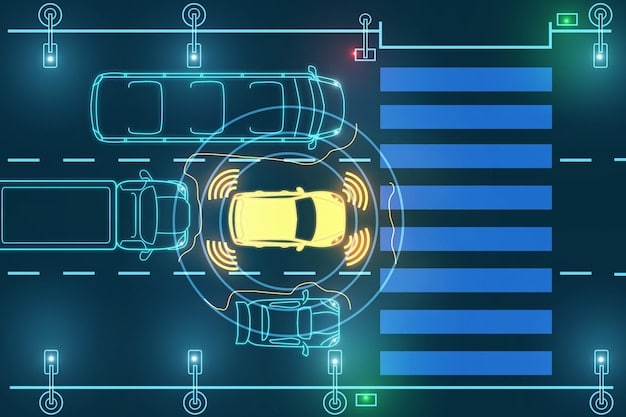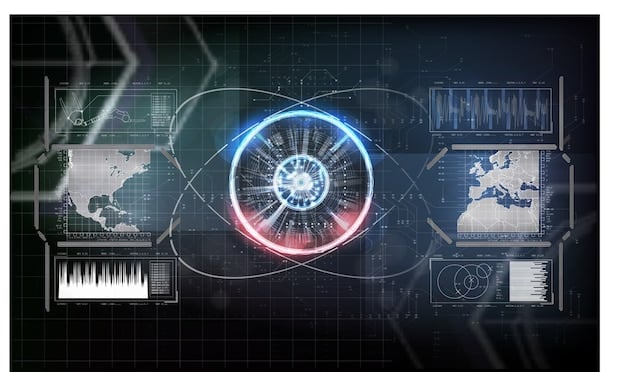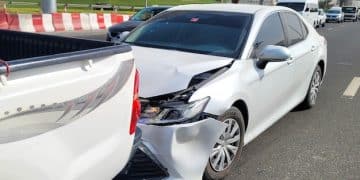Cybersecurity Alert: New Threats to Connected Car Systems

Industry Alert: New Cybersecurity Threats Targeting Connected Car Systems are emerging as vehicles become increasingly connected, posing risks to personal data, vehicle control, and overall road safety, demanding robust security measures and vigilant monitoring.
The automotive industry is rapidly evolving, with connected car systems becoming increasingly prevalent. However, this connectivity introduces a significant challenge: **Industry Alert: New Cybersecurity Threats Targeting Connected Car Systems**. As vehicles become more integrated with the internet, they are increasingly vulnerable to cyberattacks, necessitating a proactive approach to safeguard against these risks.
Understanding the Landscape of Connected Car Cybersecurity
Connected car systems offer numerous benefits, including enhanced navigation, entertainment, and vehicle diagnostics. However, this increased connectivity also expands the attack surface for malicious actors. Understanding the types of threats and vulnerabilities is crucial for developing effective cybersecurity strategies.
Common Cybersecurity Threats
Several cybersecurity threats specifically target connected car systems. These threats can compromise vehicle functionality, steal personal data, and even endanger passenger safety. Identifying these threats is the first step in mitigating their impact.
- Malware Infections: Malicious software can infiltrate vehicle systems through compromised apps, USB drives, or network connections.
- Hacking and Unauthorized Access: Attackers can exploit vulnerabilities in software or hardware to gain unauthorized control of vehicle functions.
- Data Breaches: Sensitive data, such as location history, personal contacts, and financial information, can be stolen from connected car systems.
- Denial-of-Service (DoS) Attacks: Overloading vehicle systems with traffic can disrupt functionality and prevent drivers from accessing essential features.
Vulnerabilities in Connected Car Systems
Connected car systems have several inherent vulnerabilities that make them susceptible to cyberattacks. These vulnerabilities often stem from outdated software, weak security protocols, and insufficient testing.
Addressing these vulnerabilities requires ongoing vigilance and a commitment to robust cybersecurity practices. Regular software updates, strong authentication mechanisms, and comprehensive security testing are essential for minimizing the risk of cyberattacks.

In conclusion, understanding the landscape of connected car cybersecurity involves recognizing the diverse range of threats and vulnerabilities that exist. By staying informed and proactive, manufacturers, developers, and drivers can work together to protect connected vehicles from cyberattacks.
The Impact of Cybersecurity Breaches on Automotive Systems
Cybersecurity breaches can have far-reaching consequences for automotive systems, affecting everything from vehicle performance to passenger safety. The potential impacts of these breaches underscore the importance of implementing robust security measures.
Compromised Vehicle Functionality
One of the primary impacts of cybersecurity breaches is the compromise of vehicle functionality. Attackers can gain control over various systems, including steering, brakes, and acceleration, potentially leading to accidents and injuries.
The ability to remotely manipulate these critical functions poses a significant threat to road safety. Imagine a scenario where a hacker takes control of multiple vehicles simultaneously, causing widespread chaos and collisions. Such a scenario is not only plausible but also a stark reminder of the potential consequences of inadequate cybersecurity.
Data Theft and Privacy Violations
Connected car systems collect vast amounts of data, including location history, personal contacts, and driving habits. Cybersecurity breaches can lead to the theft of this data, resulting in privacy violations and potential financial losses.
Stolen data can be used for identity theft, fraud, and other malicious purposes. Furthermore, the exposure of personal information can damage trust between drivers and manufacturers, leading to reputational damage and loss of market share.
Financial Losses and Reputational Damage
Cybersecurity breaches can result in significant financial losses for automotive manufacturers and suppliers. The costs associated with incident response, remediation, and legal liabilities can quickly add up.
- Costly Recalls: Manufacturers may be forced to issue recalls to address security vulnerabilities, resulting in significant expenses.
- Legal Settlements: Victims of cyberattacks may file lawsuits seeking compensation for damages and losses.
- Brand Erosion: Cybersecurity breaches can damage a company’s reputation, leading to a decline in sales and customer loyalty.
Ultimately, the impact of cybersecurity breaches on automotive systems can be profound and far-reaching. By prioritizing security and implementing robust protection measures, the automotive industry can mitigate these risks and safeguard the safety and privacy of drivers and passengers.
Emerging Technologies and Cybersecurity Defenses
As cybersecurity threats become more sophisticated, the automotive industry is turning to emerging technologies to enhance its defenses. These technologies offer innovative ways to detect, prevent, and respond to cyberattacks.

Artificial Intelligence (AI) and Machine Learning (ML)
AI and ML are playing an increasingly important role in cybersecurity. These technologies can analyze vast amounts of data to identify patterns and anomalies that may indicate a cyberattack.
AI-powered systems can also automate security tasks, such as threat detection and incident response. By continuously learning from new data, AI and ML can adapt to evolving threats and provide more effective protection.
Blockchain Technology
Blockchain technology offers a secure and transparent way to manage data and transactions in connected car systems. By using cryptography and distributed ledgers, blockchain can prevent unauthorized access and tampering with sensitive information.
Blockchain can also be used to secure over-the-air (OTA) software updates, ensuring that only authorized updates are installed on vehicles. This can prevent attackers from injecting malicious code into vehicle systems.
Intrusion Detection and Prevention Systems (IDPS)
IDPS are designed to detect and prevent unauthorized access to vehicle systems. These systems monitor network traffic and system logs for suspicious activity, alerting security personnel to potential threats.
- Real-time Monitoring: IDPS provide continuous monitoring of vehicle systems, allowing for rapid detection of cyberattacks.
- Automated Response: IDPS can automatically respond to detected threats, such as blocking malicious traffic or isolating compromised systems.
- Adaptive Security: IDPS can adapt to evolving threats by continuously learning from new data and adjusting its security policies accordingly.
The integration of these emerging technologies into cybersecurity defenses represents a significant step forward in protecting connected car systems from cyberattacks. By embracing innovation and investing in advanced security solutions, the automotive industry can stay ahead of evolving threats and safeguard the safety and security of its customers.
The Role of Industry Collaboration and Information Sharing
Addressing the complex cybersecurity challenges facing connected car systems requires a collaborative effort across the automotive industry. Sharing information and collaborating on best practices can help organizations stay ahead of evolving threats and strengthen their defenses.
Establishing Cybersecurity Standards and Guidelines
Industry collaboration is essential for establishing common cybersecurity standards and guidelines. These standards provide a framework for organizations to develop and implement security measures that are consistent and effective.
Standardization can also facilitate interoperability between different systems and components, making it easier to integrate security solutions across the automotive ecosystem. Organizations like SAE International and the Automotive Information Sharing and Analysis Center (Auto-ISAC) are actively working to develop and promote cybersecurity standards for the automotive industry.
Information Sharing Platforms and Communities
Information sharing platforms and communities provide a valuable resource for organizations to share threat intelligence and best practices. These platforms enable organizations to learn from each other’s experiences and collectively respond to cyberattacks.
Auto-ISAC, for example, provides a secure platform for automotive manufacturers and suppliers to share threat intelligence, vulnerability information, and incident response strategies. By sharing this information, organizations can better protect themselves and their customers from cyberattacks.
Public-Private Partnerships
Public-private partnerships can play a critical role in addressing cybersecurity challenges in the automotive industry. These partnerships bring together government agencies, industry stakeholders, and academic institutions to collaborate on research, development, and deployment of cybersecurity solutions.
- Joint Research and Development: Public-private partnerships can fund and support joint research and development efforts to create innovative cybersecurity solutions.
- Cybersecurity Awareness Campaigns: These partnerships can launch public awareness campaigns to educate drivers and consumers about cybersecurity risks and best practices.
- Policy and Regulatory Frameworks: Public-private partnerships can help develop policy and regulatory frameworks that promote cybersecurity in the automotive industry.
By fostering collaboration and sharing information, the automotive industry can strengthen its collective defenses against cybersecurity threats and ensure the safety and security of connected car systems. This collaborative approach is essential for creating a more secure and resilient automotive ecosystem.
Best Practices for Securing Connected Car Systems
Securing connected car systems requires a comprehensive approach that encompasses both technical and organizational measures. By following best practices, organizations can minimize their risk of cyberattacks and protect the safety and privacy of their customers.
Implementing Secure Software Development Practices
Secure software development practices are essential for building robust and resilient connected car systems. These practices focus on identifying and mitigating security vulnerabilities throughout the software development lifecycle.
- Security Requirements: Define clear security requirements for all software components and ensure that these requirements are integrated into the development process.
- Secure Coding Practices: Follow secure coding practices to prevent common vulnerabilities such as buffer overflows, SQL injection, and cross-site scripting.
- Code Reviews: Conduct regular code reviews to identify and fix security vulnerabilities early in the development process.
Conducting Regular Security Assessments and Penetration Testing
Regular security assessments and penetration testing are crucial for identifying vulnerabilities in connected car systems. These assessments can help organizations uncover weaknesses in their security posture and prioritize remediation efforts.
Penetration testing involves simulating real-world cyberattacks to identify exploitable vulnerabilities. By conducting these tests, organizations can gain valuable insights into their security defenses and improve their ability to detect and respond to cyberattacks.
Providing Cybersecurity Training and Awareness Programs
Cybersecurity training and awareness programs are essential for educating employees about cybersecurity risks and best practices. These programs can help employees understand their role in protecting connected car systems from cyberattacks.
Training should cover topics such as identifying phishing scams, using strong passwords, and following secure coding practices. By raising awareness and providing training, organizations can create a culture of security that permeates all levels of the organization.
By implementing these best practices, organizations can significantly enhance the security of their connected car systems and protect the safety and privacy of their customers. A proactive and comprehensive approach to cybersecurity is essential for navigating the complex challenges facing the automotive industry.
Future Trends in Connected Car Cybersecurity
The landscape of connected car cybersecurity is constantly evolving, with new threats and challenges emerging regularly. Staying ahead of these trends is crucial for organizations to effectively protect their connected car systems.
The Rise of Quantum Computing and Cryptography
Quantum computing is a rapidly emerging technology that has the potential to revolutionize cybersecurity. Quantum computers can break many of the encryption algorithms currently used to protect data and communications.
To prepare for the quantum era, organizations need to invest in quantum-resistant cryptography. These algorithms are designed to withstand attacks from quantum computers, providing a more secure way to protect data and communications.
The Increasing Complexity of Automotive Systems
Automotive systems are becoming increasingly complex, with more software and hardware components integrated into vehicles. This complexity creates new attack surfaces and vulnerabilities that attackers can exploit.
To address this complexity, organizations need to adopt a holistic approach to cybersecurity that considers all aspects of the vehicle ecosystem. This includes securing software, hardware, networks, and cloud services.
The Growing Importance of Data Privacy and Compliance
Data privacy is becoming an increasingly important concern for consumers and regulators. Organizations that collect and process personal data from connected car systems must comply with various data privacy regulations, such as the California Consumer Privacy Act (CCPA) and the General Data Protection Regulation (GDPR).
Organizations need to implement strong data governance practices to ensure that personal data is collected, processed, and stored in a secure and compliant manner. This includes obtaining consent from drivers and passengers, providing transparency about data practices, and implementing security measures to protect personal data from unauthorized access.
By staying informed about these future trends and challenges, organizations can proactively address the evolving cybersecurity landscape and protect their connected car systems from cyberattacks. A forward-thinking approach to cybersecurity is essential for ensuring the long-term safety and security of connected vehicles.
| Key Topic | Brief Description |
|---|---|
| ⚠️ Cybersecurity Threats | Malware, hacking, data breaches, and denial-of-service attacks target connected cars. |
| 🛡️ Defense Technologies | AI, blockchain, and intrusion detection systems are used to enhance security. |
| 🤝 Collaboration | Industry partnerships and information sharing are key to improving cybersecurity. |
| 🔑 Best Practices | Secure software practices and regular security assessments are essential. |
FAQ Section
▼
The main threats include malware infections, hacking for unauthorized access, data breaches compromising user information, and denial-of-service attacks affecting car services.
▼
AI improves cybersecurity by analyzing large data volumes to detect threat patterns, automating security, learning from new potential attacks, and adapting rapidly.
▼
Collaboration is essential for establishing cybersecurity standards, information sharing, and creating partnerships to address collective threats effectively and consistently across the industry.
▼
Best practices involve secure software development, regular security assessments like penetration tests, and offering comprehensive cybersecurity training for all employees in the car business.
▼
Future trends include quantum computing impacting cryptography, increased complexity in car systems creating issues, and data privacy and compliance being critical for regulation and consumer trust.
Conclusion
As connected car systems continue to evolve, the importance of cybersecurity cannot be overstated. By understanding the landscape of threats, embracing emerging technologies, fostering collaboration, and implementing best practices, the automotive industry can protect the safety, security, and privacy of its customers. Staying vigilant and proactive is essential for navigating the complex challenges of connected car cybersecurity and building a more secure future for the automotive ecosystem.





